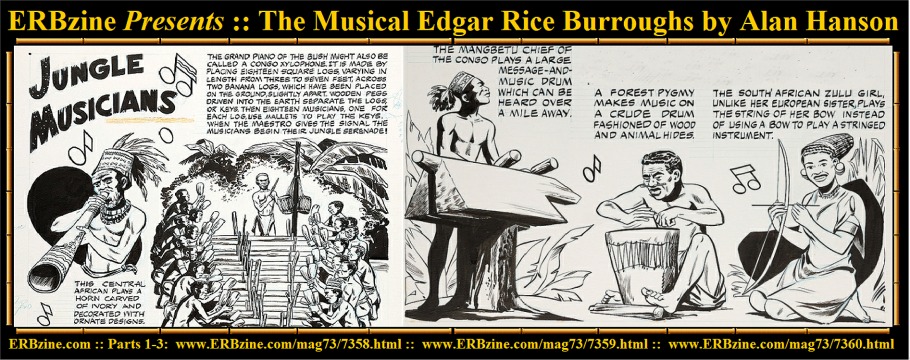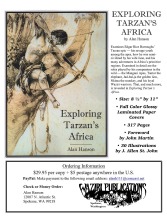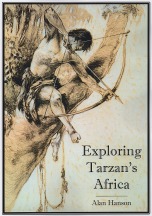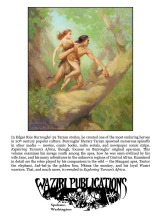
The Musical Edgar Rice Burroughs
by Alan Hanson
Part 3
Part
1 and Part
2 of“The Musical Edgar Rice Burroughs” dealt with music in the author’s
private life. Now it’s time to see how ERB wove musical elements into his
fiction.
This is the final segment in a three-part survey of “The
Musical Edgar Rice Burroughs.” Part 1 looked at the role music played in
Burroughs’ personal life. Part 2 dealt with how he worked music into his
Tarzan and Western books.
Part 3 covers musical references found in ERB’s Martian,
Venus, and Pellucidar books, as well as some of his independent novels.
Music on Mars
Like their human cousins on earth,
the red race of Barsoom appreciated the beauty of music and made it and
integral part of their civilization. They also understood music’s emotional
power to soothe or annoy individuals and groups of people. The actual sound
of music on John Carter’s Mars, however, differed greatly from that on
his home world. Rock ’n’ roll could never have taken root on Barsoom, as
narrator Vor Daj explained in Synthetic Men of Mars.
“Mars is a world of vast silences where even voiced
creatures are muted as though by the consciousness of impending death,
for Mars is a dying world. We abhor noise; and so our voices, like our
music, are soft and low … John Carter has told me of the din of Earthly
cities and of the brasses and the drums and the cymbals of Earthly music,
of the constant, senseless chatter of millions of voices saying nothing.
I believe that such as these would drive Martians insane.”
The subdued music of Barsoom, however, was just as important
to their society as loud music is to Earth’s. In A Fighting Man of
Mars, Burroughs explained, “Notwithstanding all the grim realities
with which they have to contend, the red Martians are a happy, social people.
They have their games, their dances and their songs, and the social life
of a great capital of Barsoom is as gay and magnificent as any that may
be found in the rich capitals of Earth.” During his visit to Zodanga
in Swords of Mars, John Carter took note of the “laughter
and song and occasional brawling — the sounds of the night life of a great
Martian city.”
In fact, in the cities of Barsoom’s red race, music was
the first sound nearly every citizen heard during the day. It was the Martian
alarm clock, as the following description of the early morning hours in
Lesser Helium explains. “Strains of inspiring music broke agreeably
from open windows, for Martians have solved the problem of attuning nerves
pleasantly to the sudden transition from sleep to waking that proves so
difficult a thing for most Earth folk.”
Among social circles in Martian cities, the ability to
dance is fundamental. Especially vital is mastering the Dance of Barsoom.
Burroughs detailed the importance of that dance as follows in The
Chessmen of Mars:
“The Dance of Barsoom bears a relation similar to the
more formal dancing functions of Mars that The Grand March does to ours,
though it is infinitely more intricate and more beautiful. Before a Martian
youth of either sex may attend an important social function where there
is dancing, he must have become proficient in at least three dances — The
Dance of Barsoom, his national dance, and the dance of his city. In these
three dances the dancers furnish their own music, which never varies; nor
do the steps or figures vary, having been handed down from time immemorial.
All Barsoomian dances are stately and beautiful, but The Dance of Barsoom
is a wondrous epic of motion and harmony — there is no grotesque posturing,
no vulgar or suggestive movements. It has been described as the interpretation
of the highest ideals of a world that aspired to grace and beauty and chastity
in woman, and strength and dignity and loyalty in man.”
In providing details of the dance, Burroughs gave a rare
description of a Martian musical instrument. After a bugle sound alerted
guests in John Carter’s palace to the coming dance, slaves wandered about
distributing a small, single-stringed instrument to the dancers. Strapped
to the forearm of the dancer, the instrument had a string of gut that was
played by a ring worn on the index finger of the dancer’s right hand.
John Carter and Dejah Thoris led the dancing couples that
evening, but Gahan of Gathol provided the fireworks. After the dance ended,
he stared into his partner’s eyes and said, “Tara of Helium, I love
you!” The princess was perturbed, of course, and that set the stage
for the events that followed in The Chessmen of Mars.
In that story’s events, music played an important role,
making The Chessmen of Mars the most musical of ERB’s books.
While in captivity among the Kaldanes, the mobile heads of Bantoom, Tara
sang a “gay little tune that was then popular in Helium.” Ghek,
her jailer, found the sound pleasing and asked her how she did it. “It
is difficult to explain,” she told him, “since any explanation of
it presupposes some knowledge of melody and of music, while your very question
indicates that you have no knowledge of either.” When Ghek kept asking
her to sing, Tara realized that “somewhere in that enormous brain there
was a chord that was touched by melody.”
Ghek explained the effect of Tara’s music on him as follows:
“I cannot laugh nor smile, and yet within me is a sense of contentment
when this woman sings — a sense that seems to open before me wondrous vistas
of beauty and unguessed pleasure that far transcend the cold joys of a
perfectly functioning brain.”
Tara used her singing to make Ghek protect her from being
killed and eaten by the other Kaldanes. Later, at the moment of crisis,
Tara was able to save both herself and Gahan of Gathol by raising her eyes
aloft and singing “the notes of Mars’ most beautiful melody, The Song
of Love.” That distracted Luud, the Kaldane king, long enough for Ghek
to kill him.
The Martians had their martial music, as well, but even
that was subdued compared to earthly military anthems. Later a captive
again, this time in the city of Manator, Tara of Helium stood at a window
meditating, when she heard the sound of martial music in the city below
— “the deep, mellow tones of the long war trumpets of mounted troops,
the clear, ringing notes of foot-soldiers’ music. The girl raised her head
and looked about … Now she could see across roofs and avenues to The Gate
of Enemies, through which troops were marching into the city.”
Tara of Helium came from a family of musical women. Her
mother, Dejah Thoris, supported her husband with song while he fought for
her in the throne room of Okar near the end of The Warlord of Mars.
“From behind my shoulder,” John Carter later recalled, “in the
silvery cadence of that dear voice, rose the brave battle anthem of Helium
which the nation’s women sing as their men march out to victory.” Tara’s
sister-in-law, Thuvia, had a uniquely musical tone to her voice, which
she used to control banths, the lions of Barsoom. She called the banths
to her with a sound that ERB described as a “low, singsong voice that
was half purr.”
Another Heliumite, Vor Daj, was also a captive, this time
in Amhor in Synthetic Men of Mars, when he heard music floating
through the city, though for a very different purpose than that heard by
Tara in Manator. He was “awakened by the beating of drums and the mournful
notes of wind instruments producing music that sounded very much like a
dirge.” A dirge it was. It was music that informed the citizens that
a member of their royal family had died.
When Ulysses Paxton was spirited away to Mars from a World
War I battlefield, he brought with him his earthly habit of crooning to
himself. At one point in The Mastermind of Mars, Paxton,
then known by his Martian name of Vad Varo in the house of Ras Thavas,
recalled walking toward his quarters, “moving in a leisurely and unconcerned
manner and humming, as was my wont … snatches from some song that had been
popular at the time that I quit Earth. In this instance it was ‘Oh, Frenchy.’”
Later, he is heard humming a few bars of another Earthly song, “Over
There.”
Music in Pellucidar
Musically, Pellucidar
was a place much like Tarzan’s Africa. In a world where men were killed
for simply being strangers, it was not wise for a man to walk around with
a song on his lips. As to be expected, then, there are not many musical
references to be found in Burroughs’ Pellucidar books. However, the few
to be found there are interesting ones.
We don’t know if Abner Perry did any singing during his
long stay in Pellucidar, but we do know that he sang during the journey
to get there with David Innes. As the prospector ploughed through the earth
in At the Earth’s Core, Perry’s emotions varied as the prospects
for the journey’s success fluctuated. During one stage, his optimism exhibited
itself in song. “Perry was becoming more hopeful,” David observed.
“From cursing he had turned to singing — I felt the strain had at last
affected his mind.” Of course, as Perry’s optimism died, so did the
song on his lips, as Innes noted. “At four hundred miles the temperature
reached 152 degrees. Feverishly I watched the thermometer. Slowly it rose.
Perry had ceased singing and was at last praying.”
When Innes and Perry arrived in the inner world, the Mahars
were the most advanced race. Their appreciation of music was one of the
things that set them above Pellucidar’s primitive human race. However,
their melodies were most unusual — they were music without sound. David
Innes described a Mahar concert as follows:
“The Mahars cannot hear, so the drums and fifes and
horns of earthly bands are unknown among them. The ‘band’ consists of a
score or more Mahars. It filed out in the center of the arena where the
creatures upon the rocks might see it, and there it performed for fifteen
or twenty minutes.
“Their technic consisted in waving their tails and
moving their heads in a regular succession of measured movements resulting
in a cadence which evidently pleased the eye of the Mahar as the cadence
of our own instrumental music pleases our ears. Sometimes the band took
measured steps in unison to one side or the other, or backwards and again
forward — it all seemed very silly and meaningless to me, but at the end
of the first piece the Mahars upon the rocks showed the first indications
of enthusiasm that I had seen displayed by the dominant race of Pellucidar.
They beat their great wings up and down, and smote their rocky perches
with their mighty tails until the ground shook. Then the band started another
piece, and all was again as silent as the grave. That was one great beauty
about Mahar music — if you didn’t happen to like a piece that was being
played all you had to do was shut your eyes.”
The only native humans we get to hear singing in Pellucidar
are women — Stellara in Tanar of Pellucidar and La-ja in
Back
to the Stone Age. During a peaceful period that they shared together,
Stellara sang for Tanar. She sang songs that her mother had taught her
on the island of Amiocap. La-ja, whose relationship with Von Horst was
stormy most of the time, sang for quite a different reason. “You’ll
obey me or I’ll punch your heard,” an angry Von Horst once told her.
La-ja was happy that her man had finally gotten aggressive with her. As
she walked away, “On her lips was a strange little melody, such perhaps
as women of the outer crust hummed to the singing stars when the world
was young.” There are a couple of dozen other such scenes scattered
throughout ERB’s works that have characters revealing a state of happiness
by humming or singing to themselves as La-ja did.
Music on Venus
There are a number of musical references
in Burroughs’ Venus books, as well. Two of them occur during Carson Napier’s
days as a buccaneer on the high seas of Amtor in Pirates of Venus.
One member of the ship’s crew served as a musical timekeeper. “On shipboard,
the hours are sounded by a trumpeter, there being a distinguishing bar
of music for each hour of the day,” according to Napier’s narration.
There was another musical sailor on board. Zog was a fellow
conspirator in Carson’s plot to take over the Thorist ship on which they
were prisoners. The morning of the planned mutiny, “No one would have
thought that Zog was planning to attack the soldier lolling near him …
He was humming a tune, as he polished the barrel of the big gun on which
he was working.”
Also in Pirates of Venus, the birdmen of
Amtor make an appearance. They are portrayed as a near human race made
to serve human masters. ERB referred to the klangan’s musical nature while
comparing them to a segment of earth’s population who had suffered similar
subjugation. “The klangan talked a great deal among themselves, shouting
to one another and laughing and singing, seemingly well satisfied with
themselves,” wrote Burroughs. “Their voices were soft and mellow,
and their songs were vaguely reminiscent of Negro spirituals which may
have been enhanced by the color of their skins, which were very dark.”
In Carson of Venus, Napier used his singing
talents to locate Mintep, Duare’s father, who was being held in a Zani
prison in the city of Amlot. Working undercover, Carson had obtained a
commission as a Zani officer assigned to the prison. To find Mintep without
throwing suspicion on himself, Carson came up with a musical plan, which
he outlined as follows:
“With difficulty, I wrote some very bad verse in Amtorian,
which I sang to a tune that had been popular in America when I left the
Earth. In two of the verses was the message I wished to use to elicit a
sign from Mintep that he was a prisoner there, and thus to locate his cell.
To allay suspicion, I formed the habit of singing my song as I went about
my daily duties … the fact that I was almost constantly humming or singing
my foolish song was, I felt, evidence that there was nothing irregular
or surreptitious about my activities.”
The lyrics Carson sang mentioned Duare, and sure enough,
Mintep heard and identified himself. Carson later helped Duare’s father
escape from the prison and the city of Amlot.
Carson himself was deceived by music when he and Duare
landed their anotar in the city of Voo-ad, as recounted in Escape
on Venus. As their ship came to a stop in the strange city, they
were surprised to see a friendly crowd surround the craft. “They danced
around the anotar, singing and laughing,” recalled Carson. “The
songs they sang were songs of welcome. Such a reception of strangers in
an Amtorian city was without parallel in my experience.”
Of course, the reception was too good to be true. The
singing and dancing were just deceptions used by the people of Voo-ad to
fool strangers. Before long Carson found himself paralyzed, an exhibit
hanging on a museum wall for people to gawk at. Later, he freed himself
and his fellow captives, who then in revenge set fire to the city. Seeing
Voo-ad in flames as he flew away in the anotar, Napier’s companion Ero
Shan remarked, “They will welcome no more visitors with flowers and
song.”
Other ERB Musical Moments
Scattered throughout ERB’s independent
works are a number of musical episodes. In The Cave Girl,
Burroughs made a cultural connection between music and evolving primitive
peoples of whom he often wrote. When Thandar (formerly Waldo Emerson Smith-Jones)
led his tribe of cave men to victory over the “Bad Men,” it was
cause for celebration. For the tribe Thandar created a dance, which was
not only a victory dance but also was meant to signify the move forward
on the evolutionary scale they had taken. “He knew little more of savage
dances than his tribesmen did of the two-step and the waltz,” wrote
Burroughs, “but he knew that dancing and song and play marked in themselves
a great step upward in the evolution of man from the lower orders, and
so he meant to teach these things to his people.”
Thander’s improvised dance, which consisted of alternating
primitive leaps and bounds with formal waltz steps, stirred dormant instincts
in Nadara, who was the daughter of marooned civilized parents. “With
it came an insistent urge — her feet could scarce remain quietly upon the
ground, and great waves of melody and song welled into her heart and throat,
though what they were and what they meant she did not know.” Thandar
saw in the girl’s musical outburst proof of her cultured birthright, and
that was confirmed when she, “lifted her voice in clear and bird-like
notes — a worldless paean of love and life and happiness.”
Burroughs probably had his own daughter in mind while
writing Marcia of the Doorstep in 1924. Joan had taken voice
and dance training in her teenage years and was pursuing what turned out
to be a short drama career in the early 1920s. In Marcia the struggling
parents of the title character are determined that their teenage daughter
continue her vocal training. “It would have been a calamity,” the
girl’s vocal coach declared, “had aught arisen to prevent the culture
of your so beautiful voice. One day when I am an old man it will be my
greatest pride to be pointed out as he who developed the voice of the great
diva, Marcia Aurelia Sackett!”
Marcia’s God-given musical talent was fully developed
by the end of the story. During a performance, with a famous motion picture
director in the audience, “sweet and clear, her voice rose in the ‘Jewel
Song’ from Faust and to the last note the audience sat silent, entranced.
A burst of applause manifestly inspired by real appreciation filled the
saloon, rising and falling, until Marcia indicated that she would sing
an encore. She had chosen Gottschalk’s ‘The Girl I Loved’ in the event
that she were called upon for a second song and this too was well received.”
It was the kind of performance and audience response that Burroughs could
have wished for his own daughter.
If it is only supposition that Burroughs wrote Marcia
of the Doorstep with his daughter in mind, there is absolutely
no doubt that he did so when he penned the play You Lucky Girl!
in 1927. ERB gave Joan a manuscript copy of the play and asked her to give
it to the director of the theatrical company of which Joan was a member
at the time. Obviously, Burroughs hoped the play would be produced with
his daughter in the lead role of Corrie West.
In the play, a theatrical producer overhears Corrie singing
in the small town home of a friend. “Bravo! Bravo!” he reacts. “You
have a glorious voice, Miss West. It has been excellently trained … That
voice should not be wasted … It is not only beautiful, but it is particularly
well adapted to light opera.” Corrie is spirited away to Chicago, not
to return to her hometown for three years. By then she had become the “most
popular and highest paid light opera star in America.” Again, it’s
easy to imagine Burroughs dreaming of such success for his own daughter.
The Girl From Hollywood is another Burroughs
story that has a connection to the author’s real life. ERB publicly stated
that Rancho del Ganado, the setting for most of the story’s action, was
based on his own Tarzana Ranch. Perhaps, then, the following description
from the book of a musical social gathering in the ranch house is based
loosely on similar get-togethers in the Burroughs house on the hill in
Tarzana.
“The conversation drifted to other topics until the
party at the piano broke up and Eva came dancing over to her father. ‘Gorgeous
popsy!’ she cried, seizing him by an arm. ‘Just one dance before bedtime
— if you love me, just one!’ Colonel Pennington rose from his chair, laughing.
‘I know your one dance, you little fraud — five fox-trots, three one-steps,
and a waltz.’ With arms about each other they started for the ballroom
— really a big play room, which adjoined the garage. Behind them, laughing
and talking, came the two older women, the two sons, and Grace Evans. They
would dance for an hour and then go to bed.”
Finally, from time to time Burroughs chose to use in his
stories the titles of real world tunes with which he was familiar. As noted
above, he had Ulysses Paxton sing parts of “O, Frenchy” and “Over
There” in The Mastermind of Mars, and Marcia Sackett
sang “Jewel Song” and “The Girl I Loved” in Marcia
of the Doorstep. In part two of this series, we heard that
Meriem often sang “God Save the Queen” in the Greystoke bungalow
in Africa.
There are several other isolated references to real world
melodies elsewhere in ERB’s stories. In The Man-eater, Dick
Gordon hums, “It’s nice to get up in the morning,” while happily
trudging along a jungle trail. Then, in the final part of The Land
That Time Forgot, Brady, an Irish-American sailor, hums “It’s
a Long Way to Tipperary” in an effort to lift the spirits of his companions.
Finally, in part two of The Moon Maid, Julian 9th and his
fellow conquered Americans meet infrequently in a secret church to honor
the Flag and sing “Onward Christian Soldiers.”
There are literally hundreds of musical references in
the works of Edgar Rice Burroughs, most of which have not been mentioned
in this three-part series. As a body, these musical moments in his fiction
reveal two things about the author. First, he appreciated music in its
many forms and recognized its contribution to the beauty of human life.
Second, he saw music as an important cultural element, the use and beauty
of which marked a society’s level of civilization and sophistication. In
that respect, the reader gets the feeling that in creating the musical
heritage of the Martian people, Burroughs was expressing a little disappointment
with that found on his own planet.
The End



![]()
 .
. .
.
![]()
![]()
![]()
![]()
![]()
![]()

![]()